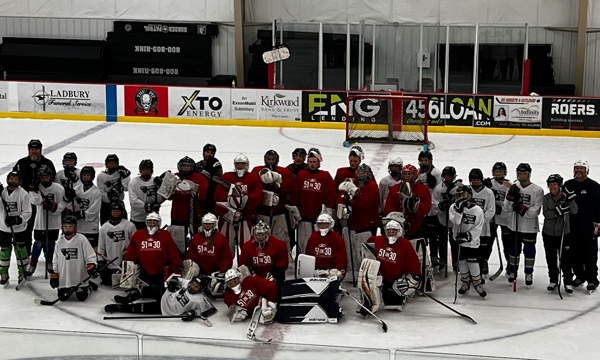Goaltending can be a harsh position at times.
Mistakes are counted on a scoreboard, and whether right or wrong, the person responsible for a goal against on the stat sheet is always the one wearing the pads.
That’s the reality, but it hasn’t stopped USA Hockey from trying to create a slightly softer opening for those in the position through district goalie camps, which were hosted in four districts — Minnesota, Mid-American, Northern Plains and Pacific — back in August.
“Our goal with our district camps is to have it be an introduction to USA Hockey for these goalies,” said Steve Thompson, the manager of goaltendingdevelopment for USA Hockey. “It’s aimed at 14-year-olds, and since we don’t have a national camp for that age group, it makes it so some kids’ introduction to USA Hockey isn’t a tryout where they could get cut and aren’t really focused on development.
“The idea is this, if you are of this age and you want to take goaltending seriously, come to this camp and we’re going to bring you the best goalie coaches from the district. And we’re going to provide all the same great resources you would get at a national camp, but just at a regional level.”
The camps are an individual opportunity for goalies. For USA Hockey, it’s a chance to make sure young talented netminders aren’t missed.
“It’s a pretty critical age from the NTDP perspective, so it also serves as an identification camp,” Thompson said. “We kind of get a long list of goalies from all these different camps and we’re going to keep an eye on them and we’ll track them as we watch for the NTDP or the U.S. Women’s National Team.”
District-based goalie camps have been around for 18 years, starting with Minnesota, and more recently have expanded to the Mid-American, Northern Plains, and Pacific districts. Some of the districts also offer elite-level shooting camps alongside the goalie camp; you need good shooters to improve the goalies.
While the camps all have a similar approach, it’s not strictly regimented by USA Hockey. This allows each district to best serve its goaltenders since each district has different challenges, be it geographically or otherwise, according to Thompson.
“We have to be flexible. That’s a big part of all these camps, letting the districts themselves best fill the need and find the way to do it,” Thompson said. “If we come in and force one thing or another, we might end up limiting the best way for each camp to be run.”
This open approach will hopefully grow the number of district camps in the future. Thompson said the long-term goal is to eventually have USA Hockey goalie camps in all 12 districts.
For example, in the Northern Plains District, which covers Montana, North Dakota, South Dakota, and Wyoming, the camp age group is more spread out. Instead of focusing on only 14-year-old goalies, Eric Woodbeck, the Northen Plains goalie coach in chief, said they expanded their camp to include goalies up to 17 years old.
“Because our hockey population is so small, we decided to open it up to more age groups,” Woodbeck said. “We were providing a better service for a more rural population, where they might not see goalie coaching much, if at all, during the season. So, a lot of times a camp like this might be the only goalie-specific coaching they get, and, in our district, we can’t limit that to one age.”
While the number of camps will ideally grow, the individual growth has been seen within the camps.
Like the approach at the national camp, which USA Hockey hosts in Plymouth, Michigan at USA Hockey Arena every year, the regional campsfocus on a program where goalies are problem solvers as opposed to being robotically programmed.
Thompson looks at this as goaltending reversing the swing of the pendulum, which started with standardized goalie coaching in the 1990s. As Thompson puts it, goalie coaching originally gave goalies a leg up, but as players started getting similar teaching and individualized instruction, the skill level in hockey reached new levels. Many goalies that were overly coached struggled, while those who found that balance between foundation and innovation have thrived.
“If you spend time at the camp, at the end of it you’ll see 50 goalies with a good foundation and they are all a little bit different after that,” Steve Carrol, who runs the Minnesota camp, said. “It’s not about making robots or one way to stop the puck, it’s about helping goalies.”
That’s music to Thompson’s ears.
“That’s exactly what we want to be, we want to be developing diverse goaltenders that solve problems in all our districts,” Thompson said. “And if that’s happening in these district camps, it lets us better serve all our goalies. It can really be a win-win.”
Story from Red Line Editorial, Inc.



